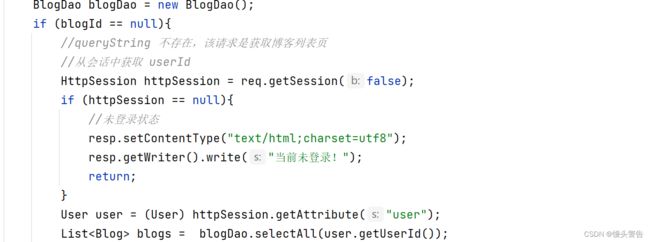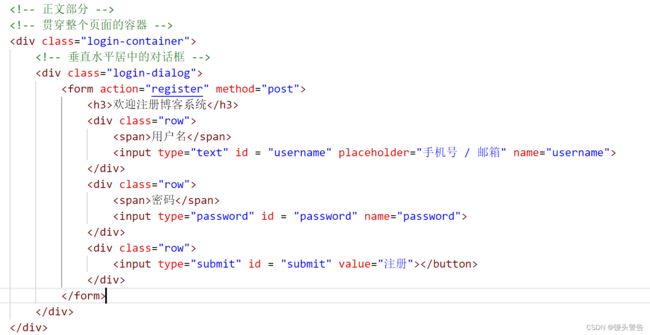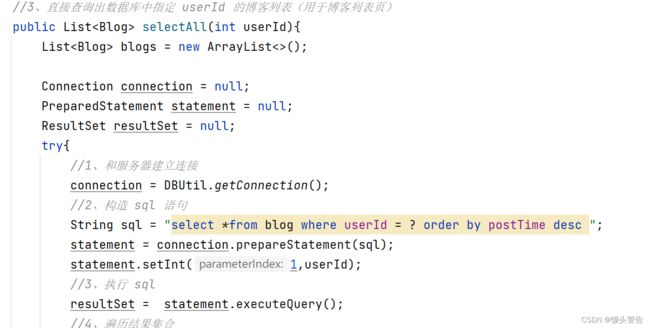博客程序系统其它功能扩充
一、注册功能
1、约定前后端接口
2、后端代码编写
@WebServlet("/register")
public class RegisterServlet extends HttpServlet {
@Override
protected void doPost(HttpServletRequest req, HttpServletResponse resp) throws ServletException, IOException {
//设置编码,告诉 Servlet 按照什么格式来理解请求
req.setCharacterEncoding("utf8");
//设置响应的编码,告诉 Servlet 按照什么格式来构造请求
resp.setContentType("text/html;charset=utf8");
//1、读取参数中的用户名和密码
String username = req.getParameter("username");
String password = req.getParameter("password");
if (username == null || "".equals(username) || password == null || "".equals(password)){
//注册失败
String html = "注册失败!缺少 username 或者 password 字段!
";
resp.getWriter().write(html);
return;
}
//2、读数据库,看看数据库中是否存在 username
UserDao userDao = new UserDao();
User user = userDao.selectByUsername(username);
if (user != null){
//用户已经存在
String html = "注册失败!该用户已经存在,请重新注册用户!";
resp.getWriter().write(html);
return;
}
//用户不存在,注册用户
userDao.add(username,password);
//注册完自动跳转到登录页面
resp.sendRedirect("login.html");
}
}
3、前端代码编写
为了添加一个注册的功能,我重新编写了一个专门用于注册的页面,该页面与登录页面类似
并且在登录页面中新添加了一个注册的按钮,当用户点击到注册按钮之后,就会自动跳转到注册页面进行注册
4、遇到的问题
当设计好注册功能后,我新注册了一个账户,并登录该账户,发现该账户虽然并没有发布任何的博客,但是仍然可以查询到别的用户发布的博客内容,于是我对 BlogDao 中的方法和 博客列表页的 doGet 进行了一些修改
在 selectAll 方法中,不再是查询全部的博客信息,而是只查询对应 userId 的博客,也就是登录的用户自己发布的博客内容 而查询的所需要的 userId 的信息,则是从 session 中获取,这样就可以将两个账户发表的博客进行一个有效的分开
而查询的所需要的 userId 的信息,则是从 session 中获取,这样就可以将两个账户发表的博客进行一个有效的分开
二、修改已发布文章功能
1、约定前后端接口
点击编辑按钮跳转到编辑页面时,使用 GET
编辑文章后提交新的文章,使用 POST
2、后端代码编写
@WebServlet("/update")
public class updateServlet extends HttpServlet {
private ObjectMapper objectMapper = new ObjectMapper();
private int BlogId = 0;
protected void doGet(HttpServletRequest req, HttpServletResponse resp) throws ServletException, IOException {
// 1. 检查当前用户是否登录
resp.setContentType("application/json;charset=utf-8");
HttpSession session = req.getSession(false);
if (session == null) {
resp.setContentType("text/html; charset=utf8");
resp.getWriter().write("当前尚未登录, 不能修改!");
return;
}
User user = (User) session.getAttribute("user");
if (user == null) {
resp.setContentType("text/html; charset=utf8");
resp.getWriter().write("当前尚未登录, 不能修改!");
return;
}
// 2. 获取到参数中的 blogId
String blogId = req.getParameter("blogId");
if (blogId == null || "".equals(blogId)) {
resp.setContentType("text/html; charset=utf8");
resp.getWriter().write("当前 blogId 参数不对!");
return;
}
// 3. 获取要修改的博客信息.
BlogDao blogDao = new BlogDao();
BlogId = Integer.parseInt(blogId);
Blog blog = blogDao.selectById(Integer.parseInt(blogId));
if (blog == null) {
resp.setContentType("text/html; charset=utf8");
resp.getWriter().write("当前要修改的博客不存在!");
return;
}else{
resp.setContentType("application/json;charset=utf-8");
resp.getWriter().write(objectMapper.writeValueAsString(blog));
}
}
protected void doPost(HttpServletRequest req, HttpServletResponse resp) throws ServletException, IOException {
// 1. 检查当前用户是否登录
req.setCharacterEncoding("utf-8");
resp.setContentType("application/json;charset=utf8");
HttpSession session = req.getSession(false);
if (session == null) {
resp.setContentType("text/html; charset=utf8");
resp.getWriter().write("当前尚未登录, 不能修改!");
return;
}
User user = (User) session.getAttribute("user");
if (user == null) {
resp.setContentType("text/html; charset=utf8");
resp.getWriter().write("当前尚未登录, 不能修改!");
return;
}
String title = req.getParameter("title");
String content = req.getParameter("content");
if(title == null || "".equals(title) || content == null || "".equals(content)){
resp.getWriter().write("");
return;
}
int blogId = BlogId;
BlogDao blogDao = new BlogDao();
Blog blog = new Blog();
blog.setTitle(title);
blog.setContent(content);
blog.setBlogId(blogId);
blogDao.update(blog);
resp.sendRedirect("blog_list.html");
}
}
此外,为了能够实现更新功能,在 BlogDao 中新增加了一个 update 方法
public void update(Blog blog) {
Connection connection = null;
PreparedStatement statement = null;
try {
// 1. 建立连接
connection = DBUtil.getConnection();
// 2. 拼装 SQL 语句
String sql = "update blog set content = ? ,title = ? where blogId = ?";
statement = connection.prepareStatement(sql);
statement.setString(1, blog.getContent());
statement.setString(2, blog.getTitle());
statement.setInt(3, blog.getBlogId());
// 3. 执行 SQL 语句
int ret = statement.executeUpdate();
if (ret == 1) {
System.out.println("编辑成功");
} else {
System.out.println("编辑失败");
}
} catch (SQLException e) {
e.printStackTrace();
} finally {
DBUtil.close(connection, statement, null);
}
}3、前端代码编写
重新编写了一个长的和发布文章类似的页面来实现编辑文章,同时在博客详情页中增加了一个 编辑的按钮
博客编辑页
4、遇到的问题
在最初代码编写的时候,我直接复用了之前发布文章的页面来实现对文章内容的修改功能,后来发现这样容易使发布功能和编辑功能混淆,最后将两个功能页面分开,重新编写了一个博客编辑的页面
三、实现用户博客总数统计
在目前的代码中,我们的博客总数是固定的,无法实时显示该用户的博客总数,于是我们加一个接口来实现这个功能
1、编写后端代码
@WebServlet("/num")
public class totalServlet extends HttpServlet {
@Override
protected void doGet(HttpServletRequest req, HttpServletResponse resp) throws ServletException, IOException {
HttpSession session = req.getSession(false);
if (session == null){
resp.setContentType("text/html;charset=utf8");
resp.getWriter().write("当前用户未登录!");
return;
}
User user = (User) session.getAttribute("user");
if (user == null){
resp.setContentType("text/html;charset=utf8");
resp.getWriter().write("当前用户未登录!");
return;
}
//确保了登录之后
resp.setContentType("text/html;charset=utf8");
String blogId = req.getParameter("blogId");
BlogDao blogDao = new BlogDao();
if (blogId ==null){
resp.getWriter().write(blogDao.selectTotal(user.getUserId())+"");
}else{
Blog blog = blogDao.selectById(Integer.parseInt(blogId));
UserDao userDao = new UserDao();
User author = userDao.selectById(blog.getUserId());
resp.getWriter().write(blogDao.selectTotal(author.getUserId()) + "");
}
}
}
此外,还在 BlogDao 中新增了一个计算个人文章总数的方法
//6. 计算个人文章的总数
public static Integer selectTotal(int userId){
Connection connection = null;
PreparedStatement statement = null;
ResultSet resultSet = null;
try {
connection = DBUtil.getConnection();
String sql = "select count(userId) from blog where userId = ?";
statement = connection.prepareStatement(sql);
statement.setInt(1,userId);
resultSet = statement.executeQuery();
return resultSet.getInt(1);
} catch (SQLException throwables) {
throwables.printStackTrace();
}finally {
DBUtil.close(connection,statement,resultSet);
}
return null;
}2、编写前端代码:
四、删除博客
1、编写后端代码
在 BlogDao 中新增一个删除的方法
public void delete(int blogId){
Connection connection = null;
PreparedStatement statement = null;
try{
//1、和数据库建立连接
connection = DBUtil.getConnection();
//2、构造 sql 语句
String sql = "delete from blog where blogId = ?";
statement = connection.prepareStatement(sql);
statement.setInt(1,blogId);
//3、执行 sql
statement.executeUpdate();
} catch (SQLException e) {
throw new RuntimeException(e);
}finally {
//进行关闭
DBUtil.close(connection,statement,null);
}
}@WebServlet("/delete")
public class DeleteServlet extends HttpServlet {
@Override
protected void doGet(HttpServletRequest req, HttpServletResponse resp) throws ServletException, IOException {
HttpSession session = req.getSession(false);
if (session == null){
resp.setContentType("text/html;charset=utf8");
resp.getWriter().write("当前未登录,不能进行删除操作!");
return;
}
User user = (User) session.getAttribute("user");
if (user == null){
resp.setContentType("text/html;charset=utf8");
resp.getWriter().write("当前未登录,不能进行删除操作!");
return;
}
//获取 BlogId
String blogId = req.getParameter("blogId");
if (blogId == null || "".equals(blogId)){
resp.setContentType("text/html;charset=utf8");
resp.getWriter().write("当前 blogId 参数不对!");
return;
}
//获取要删除的博客信息
BlogDao blogDao = new BlogDao();
Blog blog = blogDao.selectById(Integer.parseInt(blogId));
if (blog == null){
resp.setContentType("text/html;charset=utf8");
resp.getWriter().write("当前要删除的博客不存在,blogId = " + blogId);
return;
}
//删除博客内容
blogDao.delete(Integer.parseInt(blogId));
//回到博客列表页
resp.sendRedirect("blog_list.html");
}
}2、编写前端代码
3、遇到的问题
在写完代码之后,对页面进行了测试,发现:虽然可以修改代码,但是无法将原先的文章内容进行回显,于是我对前端代码进行了微调,实现回显功能
1、在 title 和 content 中加入 value 属性
2、在函数中修改 title 和 content 的赋值方式,使用 value 进行赋值
四、编辑博客
思路:
在博客详情页点击编辑博客之后,自动跳转到编辑页面,同时将原先的博客内容回显到 markdown 编辑器上,然后对原文进行编辑之后,再次提交修改即可
1、后端代码
@WebServlet("/update")
public class updateServlet extends HttpServlet {
private ObjectMapper objectMapper = new ObjectMapper();
private int BlogId = 0;
protected void doGet(HttpServletRequest req, HttpServletResponse resp) throws ServletException, IOException {
// 1. 检查当前用户是否登录
resp.setContentType("application/json;charset=utf-8");
HttpSession session = req.getSession(false);
if (session == null) {
resp.setContentType("text/html; charset=utf8");
resp.getWriter().write("当前尚未登录, 不能修改!");
return;
}
User user = (User) session.getAttribute("user");
if (user == null) {
resp.setContentType("text/html; charset=utf8");
resp.getWriter().write("当前尚未登录, 不能修改!");
return;
}
// 2. 获取到参数中的 blogId
String blogId = req.getParameter("blogId");
if (blogId == null || "".equals(blogId)) {
resp.setContentType("text/html; charset=utf8");
resp.getWriter().write("当前 blogId 参数不对!");
return;
}
// 3. 获取要修改的博客信息.
BlogDao blogDao = new BlogDao();
BlogId = Integer.parseInt(blogId);
Blog blog = blogDao.selectById(Integer.parseInt(blogId));
if (blog == null) {
resp.setContentType("text/html; charset=utf8");
resp.getWriter().write("当前要修改的博客不存在!");
return;
}else{
resp.setContentType("application/json;charset=utf-8");
resp.getWriter().write(objectMapper.writeValueAsString(blog));
}
}
protected void doPost(HttpServletRequest req, HttpServletResponse resp) throws ServletException, IOException {
// 1. 检查当前用户是否登录
req.setCharacterEncoding("utf-8");
resp.setContentType("application/json;charset=utf8");
HttpSession session = req.getSession(false);
if (session == null) {
resp.setContentType("text/html; charset=utf8");
resp.getWriter().write("当前尚未登录, 不能修改!");
return;
}
User user = (User) session.getAttribute("user");
if (user == null) {
resp.setContentType("text/html; charset=utf8");
resp.getWriter().write("当前尚未登录, 不能修改!");
return;
}
String title = req.getParameter("title");
String content = req.getParameter("content");
if(title == null || "".equals(title) || content == null || "".equals(content)){
resp.getWriter().write("");
return;
}
int blogId = BlogId;
BlogDao blogDao = new BlogDao();
Blog blog = new Blog();
blog.setTitle(title);
blog.setContent(content);
blog.setBlogId(blogId);
blogDao.update(blog);
resp.sendRedirect("blog_list.html");
}
}2、前端代码
五、管理员审核博客
1、后端代码
@WebServlet("/admin")
public class adminServlet extends HttpServlet {
@Override
protected void doGet(HttpServletRequest req, HttpServletResponse resp) throws ServletException, IOException {
HttpSession session = req.getSession(false);
if (session == null){
resp.setContentType("text/html;charset=utf8");
resp.getWriter().write("当前未登录,无法进行审核");
return;
}
User user = (User) session.getAttribute("user");
if (user == null){
resp.setContentType("text/html;charset=utf8");
resp.getWriter().write("当前未登录,无法进行审核");
return;
}
String blogId = req.getParameter("blogId");
BlogDao blogDao = new BlogDao();
ObjectMapper objectMapper = new ObjectMapper();
if (blogId == null){
//query string 不存在,则是审核详情页列表页
List blogs = blogDao.selectAudit();
String respJson = objectMapper.writeValueAsString(blogs);
resp.setContentType("application/json;charset=utf8");
resp.getWriter().write(respJson);
}else {
//query string 存在,则是审核详情页
Blog blog = blogDao.selectById(Integer.parseInt(blogId));
String respJson = objectMapper.writeValueAsString(blog);
resp.setContentType("application/json;charset=utf8");
resp.getWriter().write(respJson);
}
}
@Override
protected void doPost(HttpServletRequest req, HttpServletResponse resp) throws ServletException, IOException {
//审核通过的 post 请求
HttpSession session = req.getSession(false);
if (session == null){
resp.setContentType("text/html;charset=utf8");
resp.getWriter().write("当前未登录,无法进行审核");
return;
}
User user = (User) session.getAttribute("user");
if (user == null){
resp.setContentType("text/html;charset=utf8");
resp.getWriter().write("当前未登录,无法进行审核");
return;
}
Blog blog = new Blog();
String blogId = req.getParameter("blogId");
BlogDao blogDao = new BlogDao();
blogDao.changeStatus(Integer.parseInt(blogId),1);
resp.sendRedirect("admin_list.html");
}
} @WebServlet("/false")
public class falseServlet extends HttpServlet {
@Override
protected void doPost(HttpServletRequest req, HttpServletResponse resp) throws ServletException, IOException {
//审核不通过的 post 请求
HttpSession session = req.getSession(false);
if (session == null){
resp.setContentType("text/html;charset=utf8");
resp.getWriter().write("当前未登录,无法进行审核");
return;
}
User user = (User) session.getAttribute("user");
if (user == null){
resp.setContentType("text/html;charset=utf8");
resp.getWriter().write("当前未登录,无法进行审核");
return;
}
Blog blog = new Blog();
String blogId = req.getParameter("blogId");
BlogDao blogDao = new BlogDao();
blogDao.changeStatus(Integer.parseInt(blogId),-1);
resp.sendRedirect("admin_list.html");
}
@Override
protected void doGet(HttpServletRequest req, HttpServletResponse resp) throws ServletException, IOException {
//统计审核通过了的文章总数并返回
HttpSession session = req.getSession(false);
if (session == null) {
resp.setContentType("text/html;charset=utf8");
resp.getWriter().write("当前用户未登录!");
return;
}
User user = (User) session.getAttribute("user");
if (user == null) {
resp.setContentType("text/html;charset=utf8");
resp.getWriter().write("当前用户未登录!");
return;
}
//确保了登录之后
resp.setContentType("text/html;charset=utf8");
String blogId = req.getParameter("blogId");
BlogDao blogDao = new BlogDao();
int num = blogDao.countSuccess();
resp.getWriter().write(num + "");
}
}2、前端代码
前端代码与之前的差不多,这里就只展示一部分
六、评论
1、后端代码
@WebServlet("/comments")
public class commentsServlet extends HttpServlet {
public int blogId;
@Override
protected void doGet(HttpServletRequest req, HttpServletResponse resp) throws ServletException, IOException {
ObjectMapper objectMapper = new ObjectMapper();
HttpSession session = req.getSession(false);
if (session == null){
resp.setContentType("text/html;charset=utf8");
resp.getWriter().write("当前用户未登录!");
return;
}
User user = (User) session.getAttribute("user");
if (user == null){
resp.setContentType("text/html;charset=utf8");
resp.getWriter().write("当前用户未登录!");
return;
}
CommentsDao commentsDao = new CommentsDao();
blogId = Integer.parseInt(req.getParameter("blogId"));
List commentsList = commentsDao.selectAll(blogId);
//把 数据 转换成 json 格式
String respJson = objectMapper.writeValueAsString(commentsList);
resp.setContentType("application/json;charset=utf8");
resp.getWriter().write(respJson);
}
@Override
protected void doPost(HttpServletRequest req, HttpServletResponse resp) throws ServletException, IOException {
HttpSession session = req.getSession(false);
if (session == null){
resp.setContentType("text/html;charset=utf8");
resp.getWriter().write("当前用户未登录,不能发表评论!");
return;
}
User user = (User) session.getAttribute("user");
if (user == null){
resp.setContentType("text/html;charset=utf8");
resp.getWriter().write("当前用户未登录,不能发表评论!");
return;
}
//获取评论信息
req.setCharacterEncoding("utf8");
String content = req.getParameter("content");
if (content == null || "".equals(content)){
resp.setContentType("text/html;charset=utf8");
resp.getWriter().write("当前提交数据为空!");
return;
}//在博客详情页,对
//构造 comments 对象
String blogId = req.getParameter("blogId");
Comments comments = new Comments();
comments.setContent(content);
comments.setPostTime(new Timestamp(System.currentTimeMillis()));
comments.setBlogId(Integer.parseInt(blogId));
//插入数据
CommentsDao commentsDao = new CommentsDao();
commentsDao.add(comments);
//跳转到博客列表页
resp.sendRedirect("blog_list.html");
}
}
2、前端代码
在博客详情页添加了一个小方块来放置评论,同时在详情页的最底下增加提交评论的功能
七、统计
在普通用户页面计算通过审核的文章和未通过审核的文章,在管理员页面计算待审核的文章和审核成功的文章个数
主要通过 status 列来进行统计,这里就不再展示代码了











